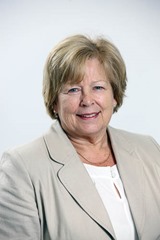Inner city junior highs
 Michele Marken discusses her ideas for improving achievement in Protestant working class areas with Peter Cheney.
Michele Marken discusses her ideas for improving achievement in Protestant working class areas with Peter Cheney.
The flag and parading disputes have focused media attention on loyalist areas over the last year and also highlighted some of the ongoing social problems affecting those communities. Educational underachievement has been one of the most significant and long-running difficulties.
Among children entitled to free school meals, just 19.7 per cent of Protestant boys and 32.4 of Protestant girls achieved five good GCSE passes in 2012. This compares with 33.2 per cent for Catholic boys and 43.8 per cent for Catholic girls in the same situation.
There has been a gradual erosion of post-primary controlled provision in areas traditionally regarded as inner-city Protestant and working-class, as schools have closed due to falling enrolments. This has conveyed a sense of neglect and a feeling of ‘not being valued’.
Michele Marken is the former principal of St Joseph’s College, a non-selective maintained school in South Belfast. One of the solutions, according to her, is as follows:
• pilot a small, community-based junior high school for 11-14 year olds;
• really work with the community to build confidence and support;
• ensure funding to counter literacy and numeracy deficits;
• establish good habits of attendance and timekeeping; and
• encourage high aspirations.
Then, transfer post-14 to other schools could be done through the strong links developed between schools, in a positive way. Parents would be fully part of the transfer decisions and wider options would be open to each child if good learning has been encouraged. This smaller school could build confidence, work on key learning skills needed and create a habit of learning.
 Such junior ‘satellites’ of the main schools normally serving inner city areas could be rolled out in other areas if the pilot proves successful.
Such junior ‘satellites’ of the main schools normally serving inner city areas could be rolled out in other areas if the pilot proves successful.
Schools must be seen as “interdependent with the community,” Mrs Marken notes. This thinking would naturally lead to a primary school and possibly a junior high school being “rooted” in neighbourhoods: “And then in areas of social deprivation, we could imagine where children didn’t have the extra burden of added travel to schools and the remoteness of those schools for positive parental and community interaction.”
Belfast’s controlled post-primary schools are often on the periphery of the city. Long bus journeys take pupils out from the inner city and back in again after school finishes. Pupils from the Sandy Row often enrol at the Boys’ Model and Girls Model schools in North Belfast. A Sandy Row parent would need to take two buses to go to the Girls’ Model or Boys’ Model. Likewise, a sick child might need two bus journeys to get home.
Some pupils may transfer to grammar schools (e.g. Inst) but this is very much the exception rather than the rule. Low income families are less able to afford tutoring for the entrance exams.
“Parents will feel content,” she says when proposing neighbourhood schools. “The school is in easy reach. You could build a stronger community because you could build the parental contribution into the life of the school.”
This could also encourage more children to come to school regularly, stay at school, sit exams and have higher aspirations. A positive affirmation programme for those young people would work better in a small school setting rather than sending them into a post-primary with 1,000 or more pupils.
Structure
The junior high (with a maximum of 300-400 pupils) would not necessarily need to be a brand new project.
‘Sponsor schools’ could be invited to come together and combine to run a ‘junior department’ which would then transfer those pupils when they complete Key Stage 3. Indeed, each sponsor school would be more confident if there was an agreement to ensure that pupils would definitely transfer to them.
At the age of 14, pupils would be more mature and confident, and a larger proportion may transfer to academic courses if they are motivated and have higher aspirations.
Area learning communities already provide a model for sharing out funding. Each of the participating schools could second teachers and have an equal say in how the new venture is managed.
Mrs Marken envisages a five-year plan to bring the idea to fruition. To take this forward, schools would have to “give up the divisions of grammar and secondary.” An example from England shows that bridges can be built between very different sectors. Wellington College – a public school led by the historian Anthony Seldon – has sponsored a new school in the state sector (Wellington Academy).
Schools will want to keep their 11-18 age range. Mrs Marken says that this can stay in place but they could recognise that, for some children, it is better to receive their 11-14 education in a more local area.
“The essence of it is putting second level education back on the ground,” she states, particularly highlighting communities on Donegall Pass, Donegall Road, Sandy Row and the Shankill Road. One school, at a central location, could serve that whole area but it would also need school buses to bring children across the busy routes that intersect it.
Ideally, the school could be attached to a primary school so that children could move up by “crossing the yard”. However, as most inner city primaries lack that space, vacant buildings or other open sites would need to be considered.
At present, the Department of Education’s policy is that small post-primary schools are not financially viable if they fall below 500 pupils. Mrs Marken wants to see a change of thinking which encourages “smaller schools which are really efficiently run.” These schools would only need to offer Key Stage 3 subjects, with the 14-18 schools delivering the wider range of GCSE subjects.
Staff in junior high schools would also have more time and space for helping children from migrant backgrounds: “You would commensurately, I would suggest, improve their chances then in life. You’d improve their success story at senior high.”
The building would also need to be user-friendly for parents who often have had a difficult experience of school themselves. A parent may feel overwhelmed when going into a large post-primary but more comfortable approaching a teacher in a smaller school. Parents would see where their children are going to school and have more time with their children, with shorter journey times.
“The best schools I go into have really open, warm, welcoming atmospheres,” Mrs Marken explains. “Better still, some of them have parents’ rooms. Some of them have parent co-ordinators i.e. people who are interfaces between the school and the parent and break down the barriers.”
Co-ordinators can be either teaching or non-teaching staff. In one school, the parents gather each Wednesday morning to exchange advice and skills e.g. learning crafts as Christmas approaches. Parents could also take up further education as shown by the work of the Girls’ Model School, amongst others.
Mrs Marken comments: “People will say: ‘It’s never been done before.’ But we can’t go on talking about Protestant working class underachievement and say ‘no’ to doing something different.”
Again, she emphasises that keeping children in school in these areas (i.e. good attendance) really matters, indeed for the rest of their lives. “If you can’t have them in the desks in front of you, you can’t affect their lives for the better,” Mrs Marken says in conclusion. “And one way of doing it might be to radically rethink how we provide education from 11 to 14.”





